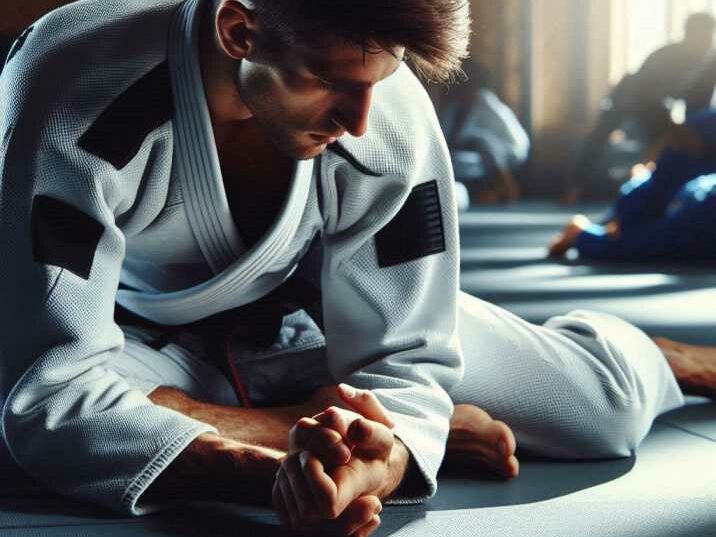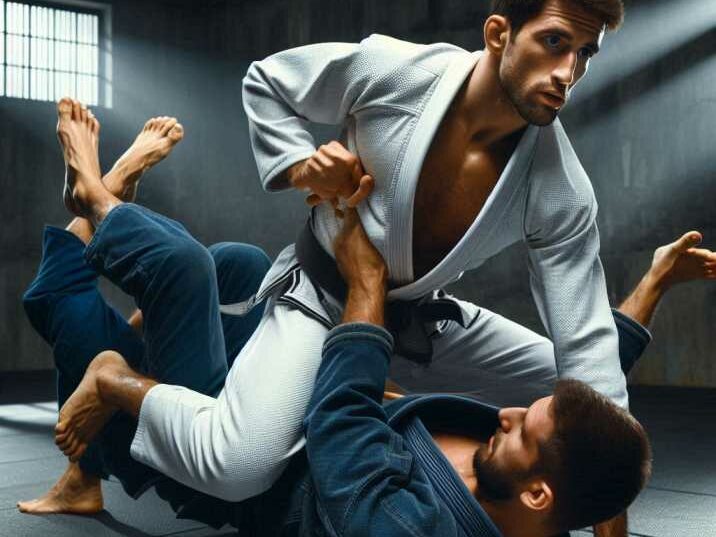Introduction
Table of Contents
Welcome to the world of Brazilian Jiu-Jitsu (BJJ), where technique and strategy often outweigh brute strength. Whether you’re a seasoned practitioner or a beginner, practicing solo drills can significantly enhance your skills. In this comprehensive guide, we’ll explore various Brazilian Jiu-Jitsu Solo Drills that will help you improve your flexibility, balance, and overall technique. These drills are perfect for those moments when you don’t have a training partner but still want to refine your skills. Let’s dive into the world of Brazilian Jiu-Jitsu Solo Drills and discover how you can become a more formidable martial artist on your own.

The Importance of Solo Drills in Brazilian Jiu-Jitsu
Understanding Solo Drills
Brazilian Jiu-Jitsu Solo Drills are exercises you can perform independently, without the need for a training partner. These drills are essential for honing specific techniques, improving physical attributes like strength and flexibility, and maintaining muscle memory. In Brazilian Jiu-Jitsu, where the intricacies of movement and position are critical,Brazilian Jiu-Jitsu solo drills provide the opportunity to focus on these elements.
Benefits of Brazilian Jiu-Jitsu Solo Drills
Improved Technique
Practicing Brazilian Jiu-Jitsu solo drills allows you to focus on the details of each movement without the pressure of a live sparring session. By breaking down techniques into smaller, manageable parts, you can work on perfecting your form and timing. This focused practice leads to smoother and more efficient techniques, which translates to improved performance when you face an opponent.
Increased Flexibility and Strength
Many solo drills in Brazilian Jiu-Jitsu are designed to improve your physical conditioning. By regularly engaging in these exercises, you enhance your flexibility, allowing for a greater range of motion in your joints and muscles. Additionally, drills like shrimping and bridging help build core strength and stability, which are essential for maintaining control and executing powerful movements on the mat.
Enhanced Muscle Memory
Repetitive practice of Brazilian Jiu-Jitsu solo drills helps ingrain specific movements into your muscle memory, allowing you to perform techniques more instinctively and with less conscious effort during live sparring. This muscle memory development is crucial for reacting quickly and effectively in the fast-paced environment of a BJJ match, where split-second decisions can make a significant difference.
Adaptability
Brazilian Jiu-Jitsu Solo drills teach you to adapt your body movements to different scenarios, enhancing your ability to transition smoothly between positions. This adaptability is crucial when facing different opponents with varying styles and strategies. By practicing a wide range of drills, you prepare yourself to handle unexpected situations, making you a more versatile and resilient practitioner on the mat.
Essential Brazilian Jiu-Jitsu Solo Drills
Here’s an expanded explanation of each essential Brazilian Jiu-Jitsu solo drill, including their descriptions, how to perform them, and their benefits:
1. Shrimping (Hip Escape)
Description: Shrimping, also known as hip escape, is one of the most fundamental movements in Brazilian Jiu-Jitsu. It helps create space between you and your opponent, making it easier to escape from bad positions such as side control or mount. By mastering this movement, you gain the ability to move your hips away from an opponent’s pressure, setting up opportunities for sweeps or submissions.
How to Perform:
- Lie on your back with your knees bent and feet flat on the floor.
- Push off with one foot, using your opposite shoulder and elbow to pivot your body sideways.
- Slide your hips away from the planted foot, keeping your other foot in contact with the ground.
- Repeat the movement on the other side, moving in a zigzag pattern across the mat.
Benefits: Shrimping improves your ability to escape from bottom positions, which is critical for maintaining a defensive posture. It also enhances core strength and flexibility, allowing you to maneuver effectively during transitions.
2. Bridging
Description: Bridging is a vital movement for escaping mount positions and reversing an opponent’s control. It involves lifting your hips off the ground to generate power and create space, allowing you to roll your opponent off or transition to a better position.
How to Perform:
- Lie on your back with your knees bent and feet close to your hips.
- Lift your hips off the ground by pressing through your feet and arching your back.
- Turn to one shoulder, using your legs to drive the movement and create space between you and your opponent.
- Lower your hips back to the ground and repeat on the other side.
Benefits: Bridging builds explosive strength in your legs and core, making it easier to escape various pinning positions. It also enhances your ability to reverse an opponent’s control, giving you the opportunity to regain a dominant position.
3. Technical Stand-Up
Description: The technical stand-up is crucial for safely getting back to your feet when you’re on the ground. This movement ensures that you maintain a defensive posture, protecting yourself from strikes or further engagement by an opponent.

How to Perform:
- Sit on the ground with one hand behind you for support and the opposite foot flat on the floor.
- Lift your hips off the ground, using your supporting hand for balance.
- Swing your free leg back and place it behind you, while maintaining a crouched, defensive stance.
- Stand up fully, keeping your guard up to protect yourself from potential attacks.
Benefits: The technical stand-up enhances your ability to transition from ground to standing safely and effectively. It is especially useful in self-defense situations, ensuring you can regain your footing while maintaining a protective stance.
4. Sprawling
Description: Sprawling is a defensive move used to counter takedown attempts. By quickly dropping your hips and extending your legs, you can prevent an opponent from securing a hold and taking you to the ground.
How to Perform:
- Begin in a standing position with your knees slightly bent and feet shoulder-width apart.
- As your opponent attempts a takedown, drop your hips to the ground while extending your legs backward.
- Use your arms to push off the mat, keeping your chest close to the ground.
- Return to a standing position and prepare to counter your opponent’s next move.
Benefits: Sprawling increases agility and helps defend against opponent takedowns, making it a crucial skill for maintaining a standing advantage in grappling exchanges.
5. Forward Rolls
Description: Forward rolls are used to improve mobility and recover from falls or failed takedown attempts. They help you transition smoothly between positions, enhancing your ability to stay active and engaged during matches.
How to Perform:
- Start in a crouched position with one foot forward and your hands on the ground.
- Tuck your chin to your chest and roll over your shoulder, using your arms for guidance.
- Use the momentum of the roll to stand up smoothly at the end, ready to engage your opponent.
Benefits: Forward rolls enhance coordination and balance, making you more fluid in transitions. They also build confidence in moving dynamically on the mat, allowing for creative solutions during sparring.
6. Backward Rolls
Description: Similar to forward rolls, backward rolls are used for transitioning and improving mobility. They help you escape from tight situations and reposition yourself advantageously.
How to Perform:
- Sit on the mat with your legs bent and your feet flat on the floor.
- Tuck your chin to your chest and roll backward over one shoulder, using your momentum to propel you.
- Return to a sitting position or stand up at the end of the roll, ready to continue your movement.
Benefits: Backward rolls improve core strength and agility, aiding in defensive maneuvers. They enable you to move efficiently from compromised positions, giving you more options in grappling exchanges.
7. Granby Roll
Description: The Granby roll is an advanced technique for escaping holds and transitioning positions. It requires flexibility and coordination, making it a valuable tool for experienced practitioners.
How to Perform:
- Start in a turtle position on your knees and elbows, keeping your body compact.
- Roll over one shoulder while maintaining a tight ball shape, using your legs to propel yourself.
- Complete the roll by returning to a controlled position, such as a guard or top control.
Benefits: The Granby roll develops agility and helps in escaping tight control situations. It allows you to transition quickly between positions, giving you an edge in scrambles.
8. Shadow Grappling
Description: Shadow grappling simulates sparring without a partner, allowing you to practice sequences and transitions. It helps you visualize and execute techniques in a fluid and dynamic manner.
How to Perform:
- Visualize an opponent in front of you, imagining different scenarios and responses.
- Move through various techniques and transitions, such as takedowns, guard passes, and submissions.
- Focus on fluidity and technique, refining your movements and preparing mentally for live sparring.
Benefits: Shadow grappling enhances muscle memory and prepares you mentally for live sparring. It allows you to practice sequences at your own pace, helping you integrate new techniques into your game.
Incorporating Solo Drills into Your Training Routine
Creating a Balanced Routine
To make the most out of solo drills, it’s essential to incorporate them into a structured training routine. Here’s a sample weekly schedule:
- Monday:
- Warm-up (10 minutes)
- Shrimping and Bridging (15 minutes)
- Shadow Grappling (15 minutes)
- Cool down (5 minutes)
- Wednesday:
- Warm-up (10 minutes)
- Technical Stand-Up and Sprawling (15 minutes)
- Forward and Backward Rolls (15 minutes)
- Cool down (5 minutes)
- Friday:
- Warm-up (10 minutes)
- Granby Roll (10 minutes)
- Shadow Grappling (20 minutes)
- Cool down (5 minutes)
Tips for Effective Brazilian Jiu-Jitsu Solo Training
- Set Clear Goals: Determine what specific skills or techniques you want to improve and focus your drills accordingly.
- Consistency is Key: Regular practice is essential for improvement. Set aside dedicated time for solo drills each week.
- Focus on Technique: Prioritize correct form and technique over speed to build a strong foundation.
- Track Your Progress: Keep a training journal to monitor improvements and identify areas that need more attention.
Conclusion
Practicing Brazilian Jiu-Jitsu solo drills is an excellent way to enhance your skills and complement your partner training. By incorporating these drills into your routine, you can improve your technique, flexibility, and overall performance on the mat. Remember, consistency and proper technique are key to making the most out of your solo training sessions. Embrace the journey of self-improvement, and you’ll find yourself becoming a more skilled and confident BJJ practitioner.
Frequently Asked Questions (FAQs)
1. Can I progress in BJJ by only practicing solo drills?
While solo drills are valuable for improving technique and physical attributes, they should complement partner training. Live sparring and partner drills are essential for applying techniques in real scenarios.
2. How often should I practice BJJ solo drills?
Aim to incorporate solo drills into your routine 2-3 times per week, alongside regular BJJ classes and partner training.
3. Do I need special equipment for solo drills?
Most solo drills require minimal equipment, such as a mat for safety and comfort. Some drills can benefit from resistance bands or grappling dummies for added challenge.
4. Can beginners practice solo drills?
Absolutely! Solo drills are beneficial for practitioners of all levels. Beginners can focus on fundamental movements to build a strong foundation.
5. How can I stay motivated to practice solo drills regularly?
Set specific goals, track your progress, and remind yourself of the benefits. Mixing up your routine and challenging yourself with new drills can also keep training exciting.


